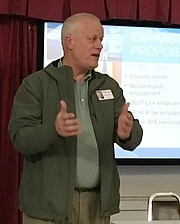Medicaid expansion allows hospital to improve offerings Program set to expire in July unless renewed by Legislature
Clark Fork Valley Hospital (CFVH) President/CEO Dr. Greg Hanson is enthusiastic when he explains how the Medicaid Expansion plan passed by the 2015 legislature has benefitted service and health outcomes in Sanders County, and its economic impact county- and state-wide.
The “expansion” helped fill a health insurance coverage gap for about 100,000 Montanans. By offering health care coverage to people who make up to 138% of the federal “poverty level,” people who earned too much to qualify for traditional Medicaid, but too little to purchase insurance through federal exchanges, were able to access medical care that could otherwise have been unaffordable. HELP LINK is a unique, and successful, Montana addition that connects Medicaid enrollees with workforce training, employment services, and job openings to help them increase earnings and get off Medicaid.
“Medicaid and Medicaid expansion now cover 11.4% of our friends and neighbors in Sanders County,” Hanson says, which is nearly 1300 people. “Many of them have family members who may be covered some other way, but that family as a whole can be affected if a member is very sick and not covered by medical insurance.”
Coverage under the expansion began in 2016 and will expire in 2019 unless it is re-authorized this legislative session. It is almost entirely funded by federal funds; the most the State will ever pay will be 10% of its cost. Besides covering new people, Medicaid expansion funds are now paying for $58 million of items the state budget used to cover, including health care for the inmate population and some mental health services. These would again come from the state budget if the program is dropped.
About 60 percent of Montana employers have at least one employee receiving health care coverage through Medicaid expansion. “There are many employers in Sanders County without the capacity to offer insurance,” that this program helps cover, says Hanson.
CFVH, EXPLAINS Hanson, is a not-for-profit community healthcare organization, including three family health clinics, that serves one of the lowest-income and highest-unemployment counties in the state. Yet they treat people regardless of their ability to pay. Some avail themselves of the charity program the hospital offers for help in these situations, but others do not, and these bills must be sent to collections. Many of these costs were never reimbursed in the past, but since Medicaid expansion has covered so many Sanders County residents, there has been a 60% overall reduction of uncompensated (bad debt and charity) care.
With Medicaid Expansion covering more patients previously unable to pay, and bringing more patients in for care, CFVH is now on stronger financial footing, giving the hospital several benefits. For one, they were able to get a lower interest rate on the loan they carry for the new building, a major cost reduction.
Additionally, CFVH has been able to add two new primary care providers and a two-person support staff for each of them, a new orthopedic surgeon so people don’t have to travel so far to get treatment for bones and joints, full-time community health improvement outreach, and a full-time care coordinator who helps “…about a hundred of our sickest friends and neighbors to stay out of the hospital, out of the emergency room, stay healthy longer.”
“We couldn’t have done any of these things,” without Medicaid expansion, Hanson says, and success stories from these local care additions abound. For example, increased cancer screenings are estimated to have averted approximately 49 local cases of colon cancer, a statistic Hanson calls, “eye popping.”
One bill, HB 425, was recently introduced which basically leaves the program as it is but adds some hospital tax that would potentially help cover the state’s portion of Medicaid costs.
ANOTHER proposed bill is expected soon that may add requirements for “community engagement” of Medicaid recipients. This would require that people are monitored to be sure they are employed, in school, taking care of a disabled family member, volunteering, in substance abuse treatment, or other activity to qualify for coverage, and assets would be taken into consideration for eligibility. Increased state funds would be required for monitoring. Currently 67 percent of Medicaid expansion recipients are employed, while many others are incarcerated, disabled, or otherwise unable to work. Up to 45 percent of current Montana recipients are estimated to lose coverage under this bill, but backers are working on options to lessen that impact. Some states that previously added work requirements face, or have already lost, lawsuits claiming those requirements are illegal.
Hanson remains optimistic that Montana will come up with a good solution. “What Montana put together in the first place was pretty unique, and has worked well,” Hanson says.
“I think our legislators will make a concerted effort to come to compromise around this with something that’s good. Nobody wants something that is going to break down [when implemented], or that the State is going to have to spend a bunch of money to defend legally. I think they’ll come up with something that’s workable for Montana.”



